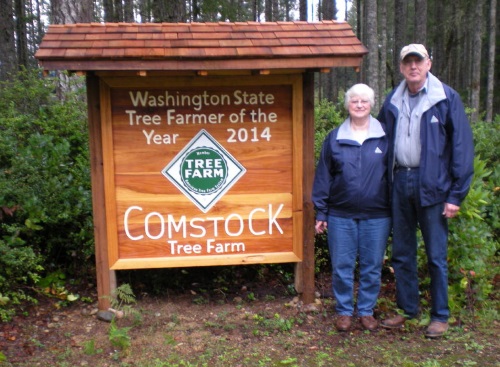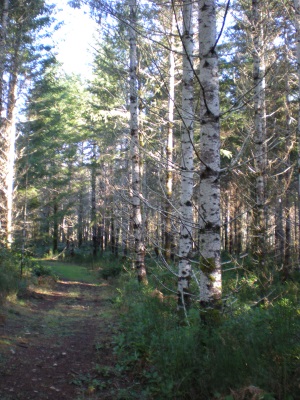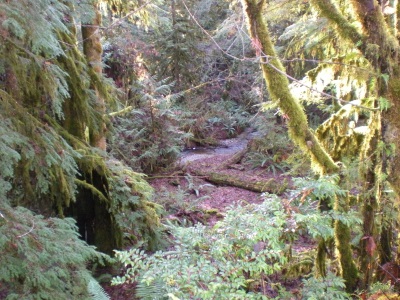Sam and Joy Comstock of Washington

What makes them outstanding?
The Comstocks acquired their Tree Farm while on a limited income paying development prices for their holdings which lie near some urban density development. Basically on a shoe string while resisting greater returns from development value. In order to be able to afford the taxes on the land they had to ensure that it was in forest use This lead to the realization that there were many benefits to tree farming and that there were political forces at play which wanted to limit their activities. It became evident that they needed to become involved with others to protect their interests and learn more about tree farming. They joined the Washington Farm Forestry Association and became certified by the American Tree Farm System Sam and Joy became president and secretary of the Olympic Chapter of WFFA for over 10 years and Sam went on to become president of the state organization and is still actively involved. Sam wrote articles for the Northwest Woodlands and the WFFA Landowner News and writes from the heart and is an advocate for all of those that toil on the land and provide the resources needed for survival by all. They have had tours of their Tree Farm and Sam isnt shy about writing a letter to the editor of the local newspaper and giving the tree farmers perspective on issues related to small family forest land owners. In addition Sam has testified at the state legislature on bills affecting small forestland owners
Tree Farmer Story
 "Joy and I are both 72 I was
born in Montana and was raised in a beach front cottage on Puget Sound. My parents were old school. We heated with wood and when my brother left
home I took his place on an old cross cut falling saw across from my father. We had nothing mechanized except for the old
1940 Chevrolet. I rowed the boat my
father and I built to fish and explore.
"Joy and I are both 72 I was
born in Montana and was raised in a beach front cottage on Puget Sound. My parents were old school. We heated with wood and when my brother left
home I took his place on an old cross cut falling saw across from my father. We had nothing mechanized except for the old
1940 Chevrolet. I rowed the boat my
father and I built to fish and explore.
Joy was born and raised in Seattle. Her parents had a summer cabin on a lake. She was raised in a more cosmopolitan way but became very resourceful and conservative. She loved the outdoors. We met thru a mutual friend whose parents had a summer place near me. We both attended Olympic Junior College in Bremerton. After serving in the Navy as an Electronic Technician Joy and I married and spent time in Long Beach and Oahu.
By 1970 we were living in Bremerton WA where I worked as a machinist apprentice in the Naval Shipyard. Joy was a stay at home mom for our three young children. We had ambitions to live a more rural life and were looking for about five acres to build on.
We found a twenty acre parcel for 11000 dollars near a lake which we had a very primitive summer cabin on. It had been logged 6 years previous but had a fair amount of standing timber. We were able to trade some of that standing timber with Clint Brown for an adjoining 10. In 1975 we sold the lake cabin and used the proceeds to acquire 16 additional adjoining acres from Clint.
Joy's mother worked at Weyerhaeusers corporate headquarters in Federal Way and she put us in touch with a Weyerhaeuser forester Gary Bordeau. Gary was working with Weyerhaeusers family tree farm program which they had pretty much phased out but we got in on the tail end of the program.
In 1978 I got a job with the Coast Guard in Kodiak Alaska where I built a home out of pocket. My parents sold their water front home and moved into our home in Bremerton and my father looked after the acreage. He would go out and pick huckleberries to make jam
At that time Gary got us a 75
percent cost share for scarification and planting of 11250  seedlings on 25
acres and I cashed out a life insurance policy to pay our portion the total
being about 8150 dollars. When Clint logged our original 20 he logged into the
creek and Joy cried a bit over the impact.
Within three years the canopy filled in and we had a beautiful little
creek looking like its desired future condition.
Gary wrote a management plan which included a 5 acre set aside for the
creek
seedlings on 25
acres and I cashed out a life insurance policy to pay our portion the total
being about 8150 dollars. When Clint logged our original 20 he logged into the
creek and Joy cried a bit over the impact.
Within three years the canopy filled in and we had a beautiful little
creek looking like its desired future condition.
Gary wrote a management plan which included a 5 acre set aside for the
creek
Since 1986 we have taken out several loads from salvage due to ice storm damage. We have Coho Salmon which infrequently put their reds down on our reach of the stream. The stream is on the order of 5 feet bank full width. In the heaviest of flows there is barely a hint of turbidity.
In 1997 we submitted a Forest Practices Application and found that we had a Bald Eagle roost within a half mile and had to write an Eagle Management Plan. Fortunately we had a WFFA forester friend Earl Kong who had been through the process on the same roost for a neighboring property. That had taken about 3 years. We were able to negotiate our plan in several weeks. Today the required riparian buffers lockup about 7 acres.
When we moved back to Washington State in 1986, I started building a home on the 10 acre parcel which used to afford us a view of Mounts Rainier Adams and Saint Helens. We consulted with the DNR and hired a private forestry consultant for advice and Joy and I took the Coached Stewardship class sponsored by Washington State University and Washington Department of Natural Resources. We wrote a new management plan bringing it up to date and incorporating the requirements for habitat protection.
Somewhere around 2006 we purchased another 5 acres contiguous to our holdings which gave us legal access to some 15 acres across the creek. In 2011 we got a call from the DNR advising that log prices were up and we should consider fulfilling some of our management plan. We hired a local forester from Shelton Jim Frost of Lusignan Forestry consultants. Within a day or so and started thinning one stand. They hand cut and used a grapple skidder shovel and CTR. We tried to thin the stand we planted in 1978 but found it difficult as the trees would hang up. Beckavar Logging came in with a hot saw to thin those trees. We ended up clear cutting about 12 acres and took out 76 loads. After burning the slash piles in October we had 4000 Weyerhaeuser seedling planted. We planted another 300 seedlings to make up for losses this last year.
To date we are fighting Scotch Broom and deer. For the deer we have used Sea Dust but the rains make it difficult to keep the seedlings treated. We have a few seedlings that are 5 to 6 feet tall, but most are stunted due to deer brows. Ive been told that at least the roots are still growing. We allow hunting and a friend took a nice buck just below the house several days ago. We had bear damage for a time when the stand we planted reached about 15 years. However once the trees became suppressed due to over stocking the bears moved on. Now that we have commercially thinned the trees have released and within three years time we have lost our view of Mount Rainier.
We bought 4 additional 5 acre parcels contiguous to ours and are holding it in open space for tax purposes It is not included in our management plan at this time."
Wood
"We treat our holdings as an income source and have learned to more aggressively manage to meet the state requirements to harvest in order to maintain our property in forest use classification for property tax purposes. At this time we have 55 acres covered by our management plan. Our last harvest was in 2011 which commercially thinned a 10 acre stand of 70 year old Douglas fir, commercially thinned a 15 acre 35 year old stand that we had planted. And did a final regeneration harvest on about 14 acres that we had commercially thinned 35 years ago. We took out 76 truck loads which grossed about $145,000. Our net return was about $75,000 plus costs for rock for some road work and seedlings and planting We had good success with our planting of 25 acres back in 1986.
When we acquired that property it was brushed in and we scarified and planted 450 seedlings per acre and at that time our first management plan was written. We planted 300 stems per acre on the clear cut of 2011 and it has been difficult to get our seedlings released. Deer browse and Scotch broom have caused us much more work. Of note is that back in 1986 we traded the value of the commercial thin of our original 20 acres for another 10 acres of ground with standing timber. We plan to reenter the stand that we planted in 1986 and thinned in 2011 for a further commercial thinning in 5 years or so. We have a five acre stand that we did not include in our Forest Practices Permit which we plan to pre commercially thin during this coming year as we have a five year permit and should be able to get a revision on our permit."
Water
"While we have several small areas that are forested wetland, we have a small beautiful creek which lies in a ravine that bisects our property. The creek is five feet, bank full width. Current forest practices regulations provide a 103 foot fixed width buffer (per an alternate harvest plan) which locks up about 7 acres from harvest compared to our original management plan of five acres. We applied through the Geographic place names and had the stream named Hoke Creek after the original settler Marion Hoke who came here in the late 1800’s. During the highest of flows there is little or no turbidity. In summer the flow is fed by seeps which is only a trickle, but provides pools for habitat for Coho Salmon fry. The Coho migrate up from tidewater which is about one mile away, in mid November. They put their reds down on the reach of the stream on our place. For a number of years I recorded the migrations and that data is included in our management plan. Now I just go down in the summer a look for fry. There is also Sea run Cutthroat that uses the stream. The indicators that fish are present are the Blue Herons which find there way down through the forest canopy and feed on the salmon fry, frogs, and crawfish and the Bald Eagles which feed on the salmon carcasses if runs are adequate. The ravine and stream have cedar, alder, fir, maple, ferns, devils club, and provide a lush shaded rain forest type condition year round. We have no crossings of the stream and found it financially feasible to purchase land for access to the east side of the stream. This precluded the construction of a crossing and the roads attendant to such."
Wildlife
"Blacktail deer use our clear cuts for forage and the forest cover for protection. Cougars are seen occasionally and thin the deer population to our benefit. We allow hunting on the place. Two bucks were taken this season. We see black bears now and again and hear crashing away through the brush when we surprise them. We live on the property so all the critters come through the yard, which also includes coyote and river otter. A bear raided our garbage can several nights in a row. Later on a bear found a soft spot in the door jamb and ripped the jam and door off and got to the cans. I beefed the door and jamb up and have had no further problems. There is a Bald Eagle roost about one half mile to the north. The Hoke Creek drainage from the roost to tidewater is listed as critical habitat by the state. At one point we had to write an Eagle Management plan to acquire a Forest Practices permit as the Eagle roost is within one half mile of the harvest.
More recently with the Bald Eagle being delisted we have not been required to provide an eagle management plan for any harvests. Current forest practices rules with regard to riparian areas provide the necessary protections for the Bald Eagle roost. We have noticed that we do not hear Ruffed Grouse drumming or skunk around. These are not protected species. We think the Opossums which are not indigenous may be the problem for the skunks at least. We hope that with our recent clear cut the Grouse will return. Of coarse salmon are a priority and we feel we are doing more than our fair share for there survival, while they continue to be harvested commercially?"
Recreation
"We feel this is our own private park. We have views of Mount Rainier to the east and the Olympic Mountains to the west. We can hear the sea lions barking down at tidewater and have beach access there. Likely the most special site is our creek which has all the beauty of any forest one could find in the North West. It is extremely quiet down in the creek with only the murmur of the creek’s flow to soothe ones soul. A great blue heron may startle and rise through the forest canopy. A raven may call out in its primeval way and you will hear the beat of its wings passing overhead. In the spring when we’re out working in the woods, we will hear a flock of geese passing high overhead going north or the scream of an eagle and see them floating high in the clear blue sky. In the fall we will be out splitting fire wood on a clear cool day and hear the sandhill cranes call as they pass in their vee headed south. We share our land with neighbors and friends, whether they hunt with bow or rifle or wish to walk or ride their ATV. We have brush pickers who pick the huckleberry and salal for the floral green business that thrives in our area. We do not charge for such a lease, but feel comfortable having folks we know on the place. Mushrooms are a favorite treat in the fall. Chanterelles and matsutake we know the best. We will have a fire in a summer evening and gaze into the flames and feel the bond we have had over the centuries with the land and nature while bats chase overhead through the twilight. We can not imagine living anywhere else."


